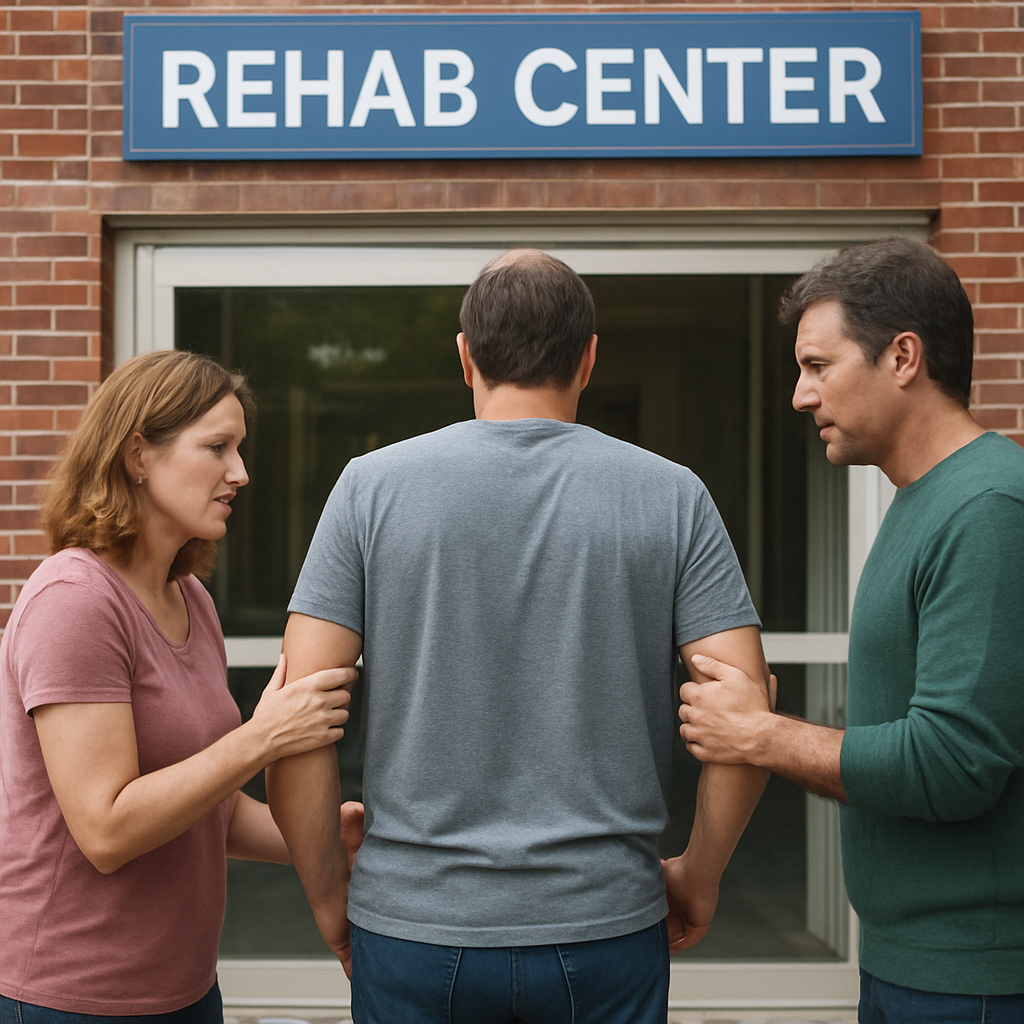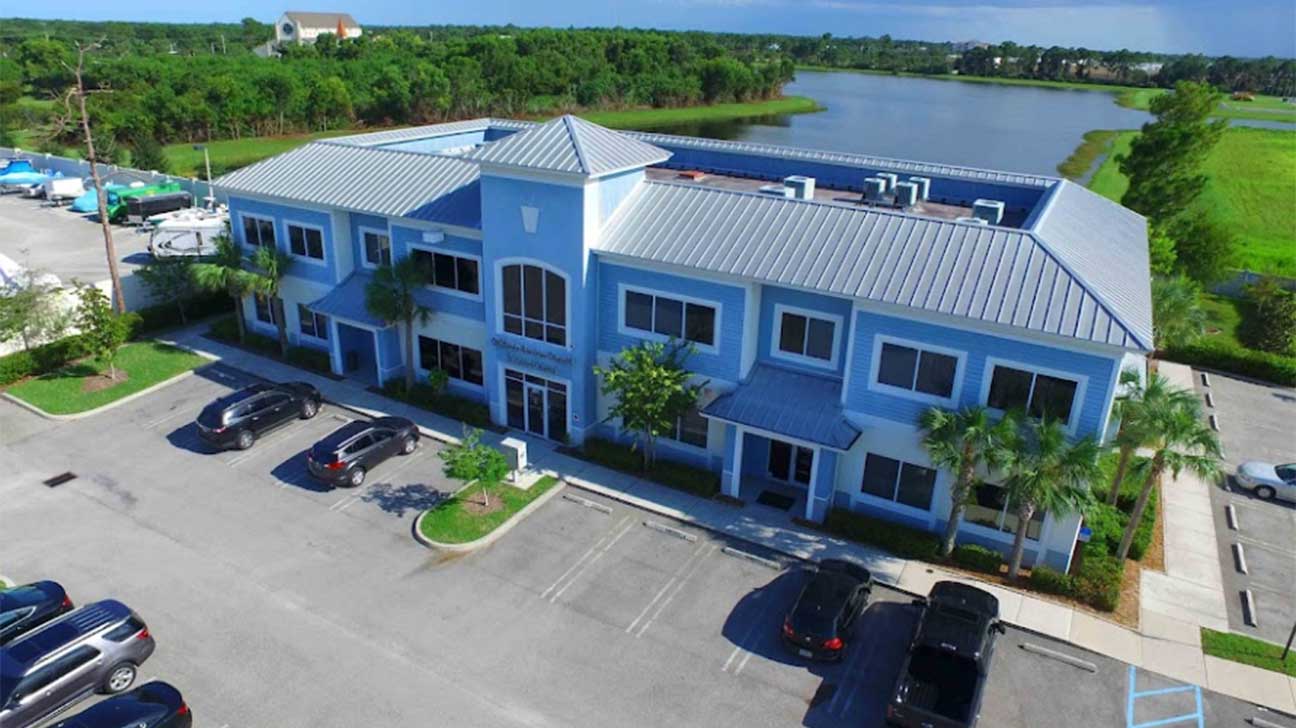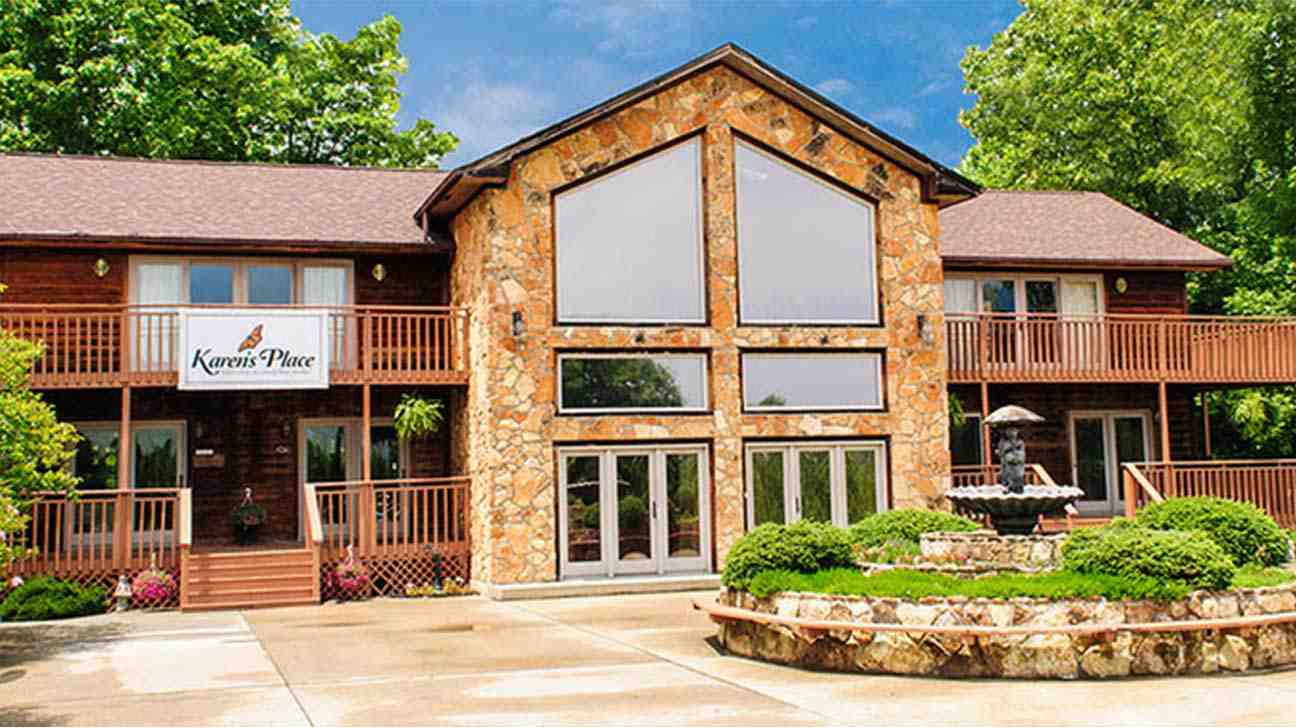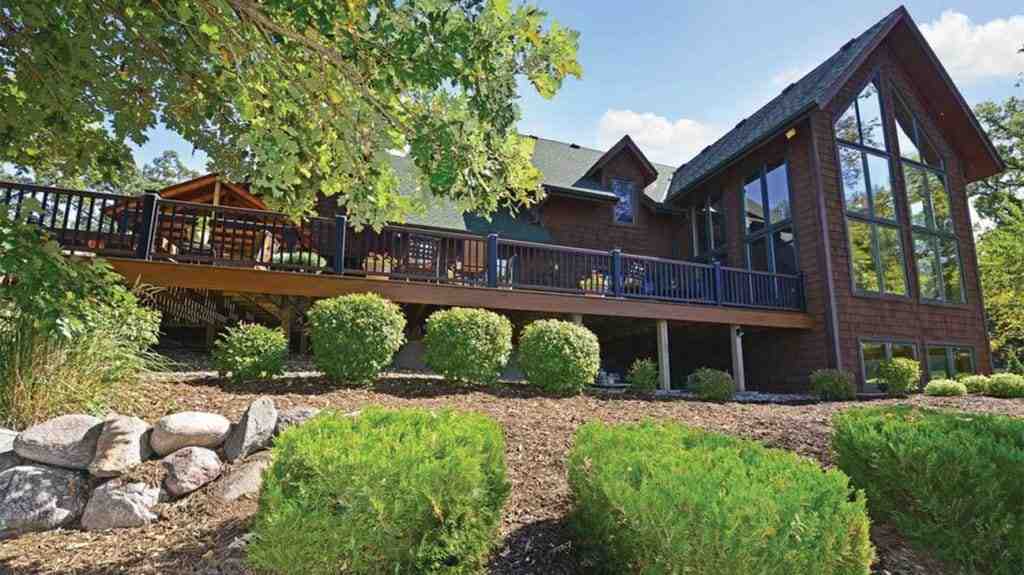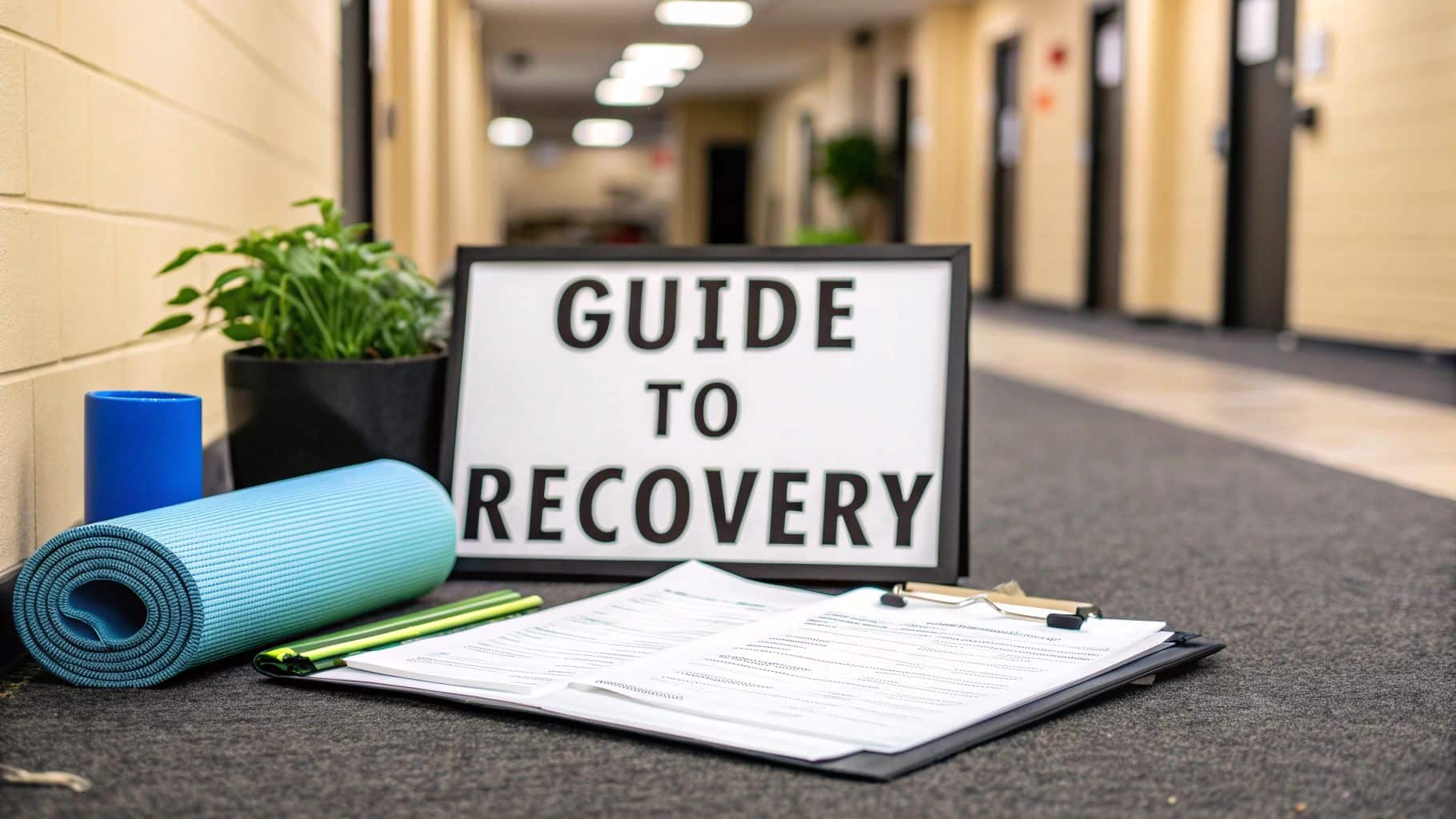
When you decide to seek help, knowing what to expect in rehab can replace a lot of that fear with confidence. At its heart, rehab is a structured, supportive program designed to guide you through a clear process: from admission and assessment to the core treatment itself, and finally, planning for a life in recovery.
Your First Step: Demystifying the Rehab Journey
Making the decision to go to rehab is a huge, courageous first move. It’s completely normal to feel a mix of hope and nervousness about what lies ahead. But the process isn’t some big mystery; it’s a carefully structured path designed to give you the support and skills you need for real, lasting change.
Think of it like a training program for a healthier life, where every single step has a clear and important purpose.
This journey is about so much more than just stopping substance use. It’s about healing on every level—physically, mentally, and emotionally. The entire environment is built to be a safe space, away from the triggers and stresses of your daily routine, so you can focus completely on yourself and your well-being. This structured approach is what helps you build a solid foundation for recovery.
The Core Components of Treatment
A good rehab program isn’t a one-trick pony. It brings together several key elements to make sure your recovery is well-rounded and strong. This infographic below breaks down the three central pillars that form the backbone of most quality treatment programs.
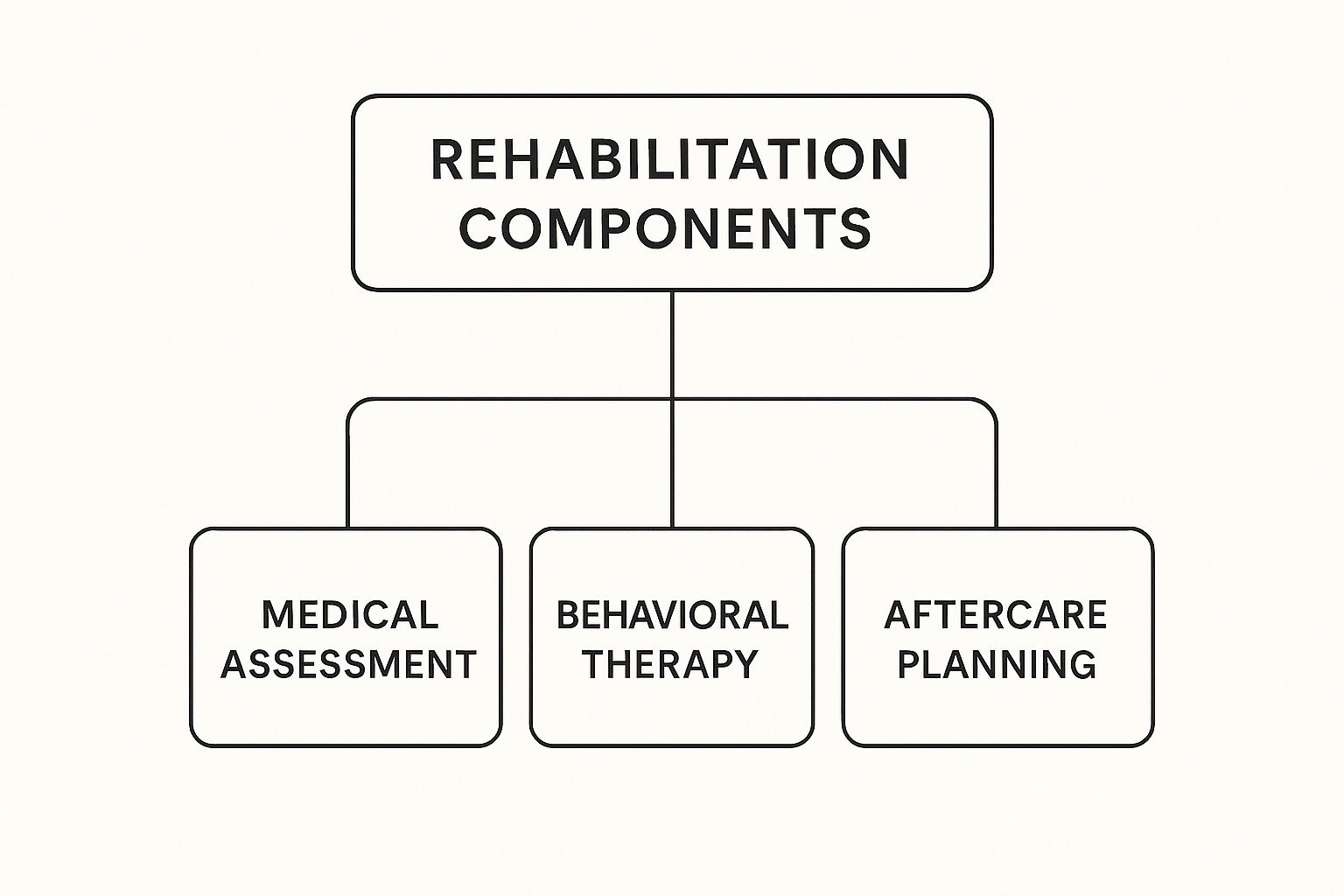
As you can see, your journey is built on a medical assessment to keep you safe, behavioral therapy to help you build coping skills, and aftercare planning to support your long-term success. Each piece is essential for a recovery that sticks.
A Growing Global Need for Support
If you’re thinking about rehab, you are definitely not alone. The need for these kinds of services has been rising significantly all over the world. Back in 2019, an estimated 2.41 billion people—that’s about one-third of the entire world’s population—had a condition that could benefit from rehabilitation.
That number represents a staggering 63% increase in the need for these services since 1990. It really shows how much rehabilitation has become a recognized and vital part of modern healthcare. You can dive deeper into these statistics by exploring the World Health Organization’s findings on global rehabilitation trends.
“A quality rehab program doesn’t just put a band-aid on the symptoms of addiction; it addresses the whole person. It gives you the tools, perspective, and support network needed to rebuild your life on a new, healthier foundation.”
From the moment you walk through the doors, the focus is on creating a plan that fits you. This isn’t a one-size-fits-all program but an experience tailored to meet you exactly where you are. Every element, from your individual therapy sessions to group discussions, is designed to empower you, build your resilience, and help you connect with others who truly understand what you’re going through.
It’s this compassionate, structured approach that makes rehab such a powerful catalyst for change.
To give you a clearer picture of the road ahead, let’s break down the journey into its main stages. This table provides a quick-glance overview of the entire process you’ll navigate during your stay.
The Four Key Phases of Your Rehab Experience
| Phase | What It Involves | Primary Goal |
|---|---|---|
| 1. Admission & Assessment | Intake paperwork, medical evaluation, psychological screening, and initial detox (if needed). | To safely manage withdrawal and create a personalized treatment plan based on your unique needs. |
| 2. Detoxification | Medically supervised withdrawal from substances. The focus is on safety and comfort. | To clear your body of substances and stabilize your physical health before therapy begins. |
| 3. Core Treatment & Therapy | A mix of individual counseling, group therapy, family sessions, and holistic activities. | To address the root causes of addiction, develop healthy coping skills, and begin healing. |
| 4. Aftercare & Discharge | Creating a continuing care plan, finding support groups, and setting up outpatient therapy. | To provide a strong support system that helps you maintain sobriety and thrive after leaving the facility. |
Each phase builds on the last, creating a comprehensive support structure that guides you from your first day all the way through to a successful, sober life on your own terms.
Navigating Your Arrival: What to Expect During Intake
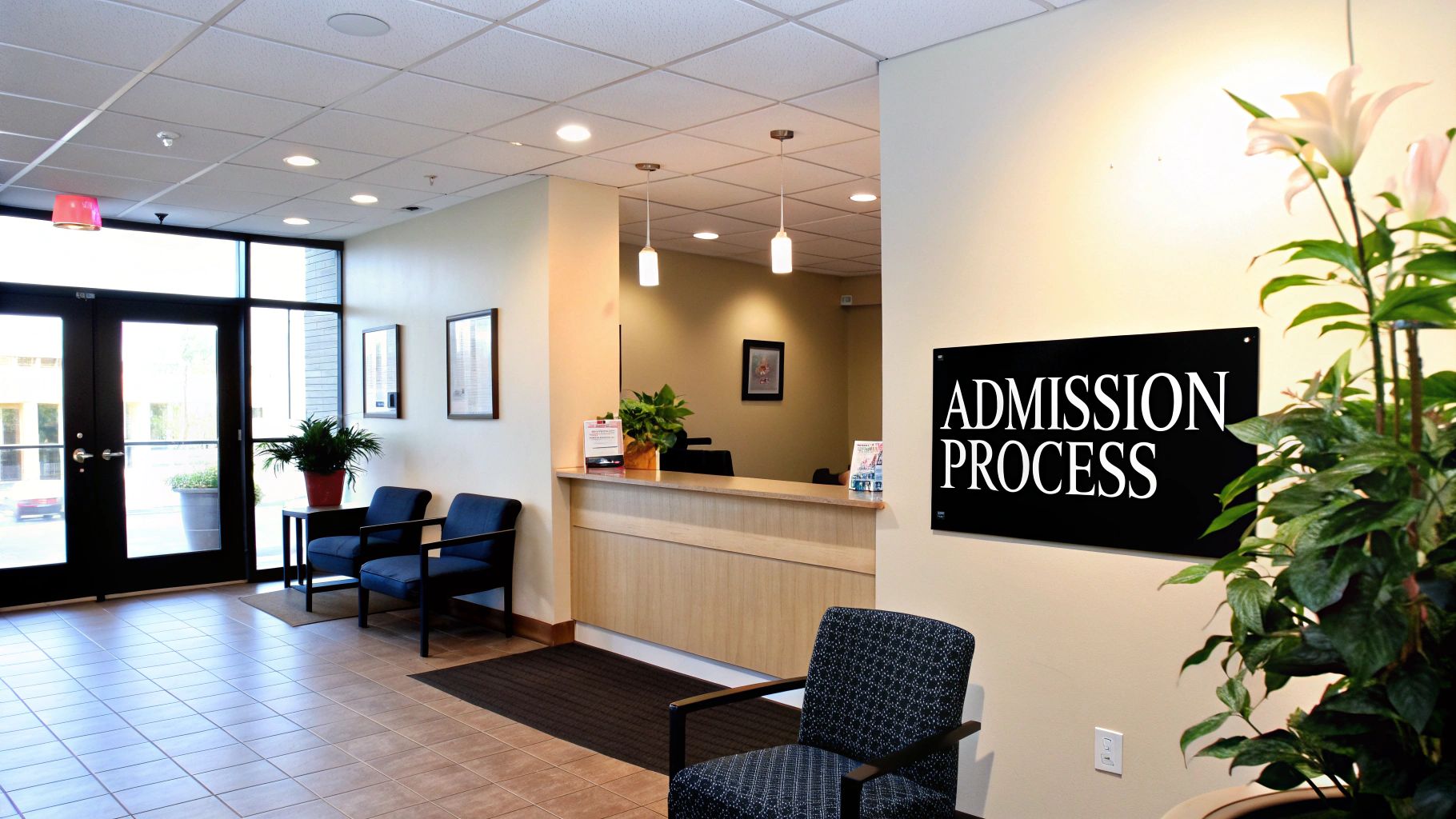
Walking into a treatment center for the first time is a huge step. It’s completely normal to feel a mix of hope, fear, and a thousand other emotions. Knowing what the intake process involves can help calm those nerves, showing you it’s a structured and confidential first step designed to get you the best possible care.
Think of intake less like an interrogation and more like a detailed conversation. This is where the clinical team starts to understand who you are beyond your addiction. It’s the foundation for building a recovery plan that’s actually right for you.
The First Steps Happen Before You Arrive
Your journey to recovery often kicks off with a simple, confidential phone call. You’ll speak with an admissions counselor who is there to answer your questions and help you figure out if the program is a good fit.
This initial call is your chance to get the basics sorted out. You’ll typically discuss:
- Logistics and Insurance: This is where you can verify your insurance benefits or talk through payment options, clearing up financial questions right away.
- Initial Screening: They’ll ask some general questions about your situation and substance use. It’s a brief chat to make sure the facility can meet your specific needs.
- What to Bring: You’ll get a clear list of what to pack (like comfy clothes and a notebook) and what to leave behind to avoid distractions.
Pay close attention during this call. The way a facility’s team handles your first contact can tell you a lot about the quality of care they provide. For a deeper dive, our guide on choosing the right rehab facility has some great tips on this.
What Happens on Your First Day
When you get to the facility, you’ll be greeted and brought into a calm, supportive space. The first day is all about assessments, which are the building blocks of your personalized treatment plan. The staff knows this can be overwhelming, so they won’t rush you.
You’ll sit down with a clinician for what’s called a biopsychosocial assessment. It sounds complicated, but it’s really just a comprehensive, private conversation. It covers your biological (health history), psychological (mental wellbeing), and social (family, work, environment) background. Being open and honest here is crucial—it gives the team the full picture they need to help you effectively.
Important Takeaway: “The entire intake process is a confidential dialogue. Laws like HIPAA protect your privacy, ensuring that everything you share is used only to create a treatment plan that addresses your unique needs and recovery goals.”
A medical evaluation is also a key part of day one. A doctor or nurse will conduct a physical exam and go over your medical history. The main goal here is to ensure your safety, particularly if you require a medically supervised detox. This assessment helps the medical team prepare to manage any withdrawal symptoms and keep you as comfortable as possible.
After the assessments, you’ll get a tour of the facility and be shown to your room. This is your chance to settle in and get familiar with what will be your home for a little while. Your first day is busy, but every single step is designed with one thing in mind: setting you on the path to a lasting recovery.
A Look at Daily Life Inside a Rehab Center
It’s easy to let your imagination run wild when thinking about what daily life in rehab is actually like. Most people picture a sterile, overly strict environment, almost like a hospital or a boot camp. But the reality is far more supportive and, frankly, more human than that.
The structure you’ll find isn’t about control; it’s about creating a predictable and safe rhythm for your life. When you’re caught in the cycle of addiction, life is often chaotic and unpredictable. A well-designed daily schedule is the perfect antidote. It brings a sense of calm and routine, which frees up your mental and emotional energy to focus on what really matters: your recovery.
The Rhythm of a Typical Day
While every rehab center has its own unique approach, most residential programs follow a similar daily blueprint. The day is full, but it’s purposefully designed to be productive without feeling overwhelming. The goal is to create a healthy balance of therapy, education, self-reflection, and connection with others.
Instead of waking up and wondering what to do—a situation that can be a huge trigger in early recovery—the schedule gives you a clear path.
- Morning: Days often begin early with a nutritious breakfast, followed by an activity to center your mind. This might be a quiet meditation session, a gentle yoga class, or some time for journaling before the day’s main therapies begin.
- Mid-Day: After your morning sessions, you’ll have lunch, usually with your peers. This is a great time for informal chats and building a sense of community.
- Afternoon: This part of the day is typically dedicated to more therapeutic work. You might participate in specialized workshops, have a family therapy session, or engage in holistic treatments.
- Evening: After dinner, the pace slows down. The evening might involve a 12-step meeting, a group session to reflect on the day’s progress, or just some quiet time for yourself before bed.
Here’s a sample schedule to give you a clearer picture of how these elements come together.
A representative schedule illustrates how a typical day is structured to balance therapy, education, and personal well-being.
Call Now – Your Journey to Recovery Begins Today!

Take the first step towards a healthier life! Call now to connect with our compassionate team and start your recovery journey today. Your path to healing awaits!
Our recovery specialists are available 24/7 to provide support, and all calls are confidential and free. Reach out anytime – we’re here to help!
Sample Daily Schedule in Rehab
| Time Slot | Activity | Purpose |
|---|---|---|
| 7:00 AM – 8:00 AM | Wake-up & Breakfast | Starting the day with routine and proper nutrition. |
| 8:30 AM – 9:30 AM | Mindfulness/Meditation | Centering the mind and reducing stress for the day ahead. |
| 9:45 AM – 11:00 AM | Group Therapy | Sharing experiences and learning from peers in a guided setting. |
| 11:15 AM – 12:15 PM | Individual Counseling | One-on-one time with a therapist for personalized work. |
| 12:30 PM – 1:30 PM | Lunch & Free Time | A break for nourishment and informal social connection. |
| 1:45 PM – 3:00 PM | Educational Workshop | Learning about the science of addiction and coping skills. |
| 3:15 PM – 4:30 PM | Holistic Therapy (Yoga, Art) | Healing the mind and body through alternative approaches. |
| 5:00 PM – 6:00 PM | Personal Time/Journaling | A quiet period for self-reflection and processing the day. |
| 6:00 PM – 7:00 PM | Dinner | Community meal to build fellowship. |
| 7:30 PM – 8:30 PM | 12-Step Meeting or Wrap-up | Reinforcing recovery principles and peer support. |
| 9:00 PM – 10:00 PM | Quiet/Relaxation Time | Winding down before sleep to ensure proper rest. |
This kind of structure helps you build a solid foundation of healthy habits that you can carry with you long after you complete the program.
The Core Activities of Healing
Throughout the day, you’ll engage in a variety of activities, all designed to help you understand the roots of your addiction, develop practical coping skills, and build a new life in recovery.
“The real power of a daily schedule in rehab is that it helps you build new, healthy habits that you can take with you long after you leave. It’s a practical training ground for a life in recovery.”
The cornerstone of any good program is therapy. One-on-one counseling gives you a safe, confidential space to dig into your personal history and triggers. At the same time, group therapy is incredibly powerful because it shows you that you’re not fighting this battle alone. Hearing from others who understand what you’re going through is one of the most validating experiences in recovery.
Many centers also weave in holistic therapies to support your overall well-being. This can include:
- Art or Music Therapy: A creative way to express feelings that are sometimes too difficult to put into words.
- Yoga and Mindfulness: Practices that help you reconnect your mind and body, manage stress, and stay grounded in the present moment.
- Nutritional Guidance: Learning how the right foods can fuel your brain and body, which is crucial for both physical and mental healing.
This comprehensive approach is part of a larger trend in addiction treatment. The global market for rehabilitation equipment, for example, is expected to hit around $27.29 billion by 2030. This investment isn’t just about fancy machines; it’s about a deep commitment to finding better, more effective ways to help people heal. You can read the full report on rehabilitation equipment market innovations to see how technology is continuing to improve care.
Ultimately, daily life in rehab is a carefully planned experience. It’s an active, supportive environment where every part of the day is an opportunity to learn, grow, and heal from the ground up.
The Heart of Healing: Core Therapeutic Approaches
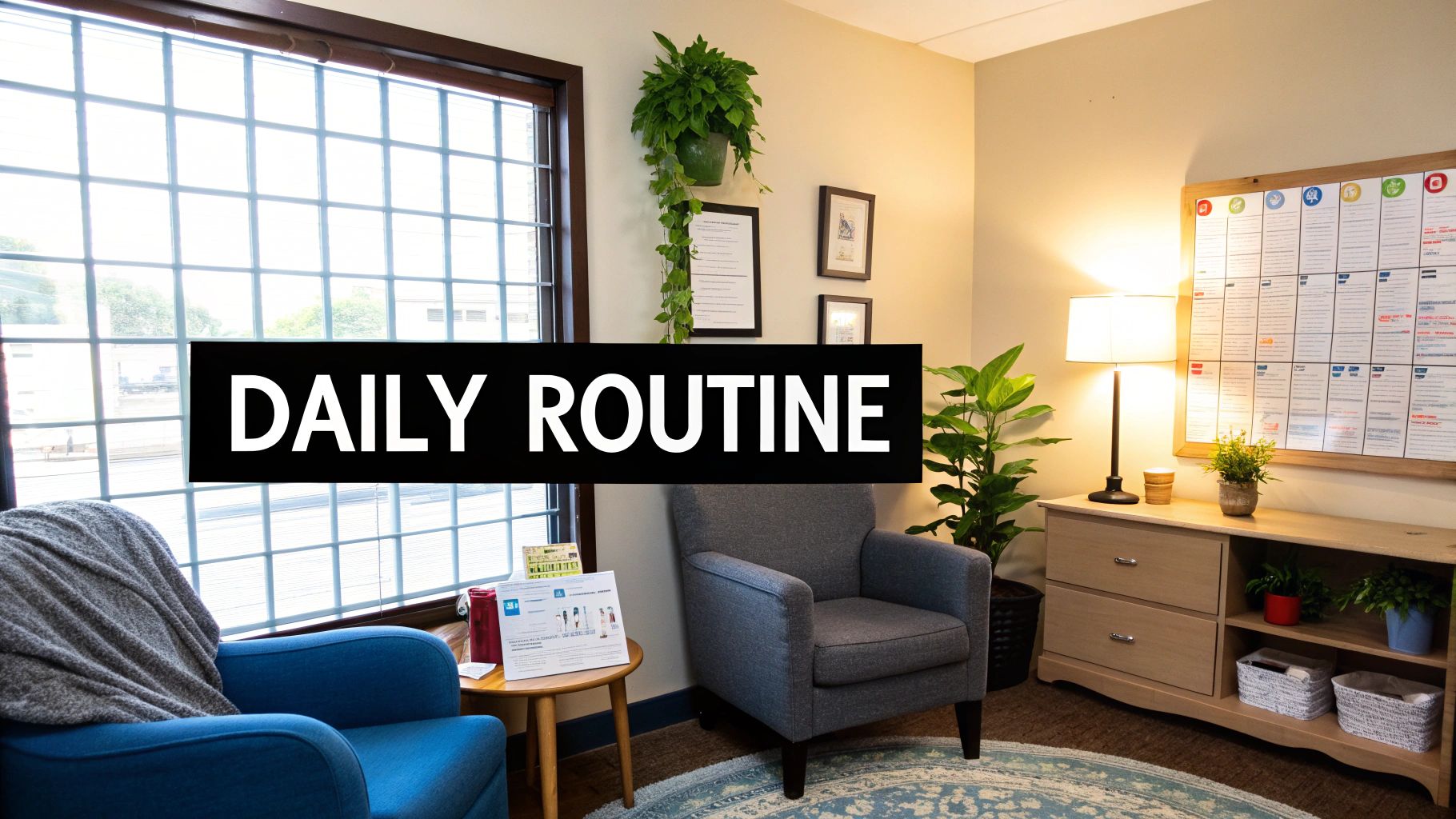
If a structured daily schedule is the skeleton of your rehab experience, then therapy is its heart—the engine that powers profound and lasting change. This is where you move past just stopping the substance use and start to heal the underlying reasons that led you there in the first place. When you first hear about the different types of addiction therapy, it can all sound a bit clinical and intimidating. But really, these are just proven, structured ways to help you rediscover yourself.
These therapeutic methods aren’t just academic theories pulled from a textbook. They are practical, field-tested tools designed to give you new ways of thinking, feeling, and behaving, empowering you to finally break free from the automatic, destructive patterns of addiction.
Changing Your Thoughts to Change Your Life
One of the most foundational approaches you’ll almost certainly encounter is Cognitive Behavioral Therapy (CBT). The idea behind CBT is actually quite simple: our thoughts, feelings, and actions are all linked. When we get stuck in negative or distorted thinking, it triggers painful emotions, which can then lead straight to destructive behaviors like using drugs or alcohol.
Think of your negative thought patterns as a well-worn path through a forest—it’s the easiest, most automatic route to take. CBT acts as a guide, helping you first see that old path for what it is and then showing you how to forge new, healthier trails. You’ll learn to spot the specific thoughts that trigger cravings and then challenge and reframe them in a more realistic, positive light.
For example, a thought like, “I’ve messed up again, so I might as well use,” can be consciously changed to, “This is a tough moment, but using will only make it worse. I have other ways to cope now.” It takes practice, but over time, this builds incredible mental resilience and forms new, healthier habits.
“Therapy provides the essential space to untangle the complex knots of addiction. It’s not about blame; it’s about understanding the ‘why’ behind the ‘what’ and building a new set of skills for a different future.”
This focus on building new skills is the cornerstone of modern recovery. It’s why rehabilitation is such a vital and growing healthcare sector worldwide. The global market for medical rehab services was valued at around USD 287.28 billion in 2025 and is projected to climb to roughly USD 492.4 billion by 2034. That stunning growth, detailed in this full market analysis about medical rehabilitation services, highlights a global commitment to providing effective healing strategies.
Managing Emotions and Relationships
Another powerful tool you might use is Dialectical Behavior Therapy (DBT). While it shares roots with CBT, DBT has a special focus on managing intense, overwhelming emotions and navigating difficult relationships—two areas where many people in recovery really struggle.
DBT is all about teaching practical skills in four key areas:
- Mindfulness: Learning to stay grounded and present in the moment, without judgment.
- Distress Tolerance: Finding healthy ways to get through painful moments without reacting impulsively.
- Emotion Regulation: Understanding your own emotions and learning how to influence them, rather than being controlled by them.
- Interpersonal Effectiveness: Clearly communicating your needs and setting boundaries in a respectful way.
These skills are invaluable, giving you a real-world toolkit to handle the emotional turbulence that often comes with early recovery.
The Power of Connection in Group Therapy
While individual therapy is crucial for that deep, one-on-one work, group therapy offers something different but just as vital. Addiction absolutely thrives in isolation. Group therapy is its direct antidote.
There is incredible power in sitting in a room with other people who genuinely understand what you’re going through. It shatters the walls of shame and secrecy, proving you are not alone in this fight. In these therapist-guided sessions, you’ll share your experiences, learn from others, and practice new ways of communicating in a safe, supportive space.
This shared journey forges a powerful sense of community and accountability—two things that are absolutely essential for building a lasting recovery.
Call Now – Your Journey to Recovery Begins Today!

Take the first step towards a healthier life! Call now to connect with our compassionate team and start your recovery journey today. Your path to healing awaits!
Our recovery specialists are available 24/7 to provide support, and all calls are confidential and free. Reach out anytime – we’re here to help!
Preparing for Life After Rehab: Discharge and Aftercare
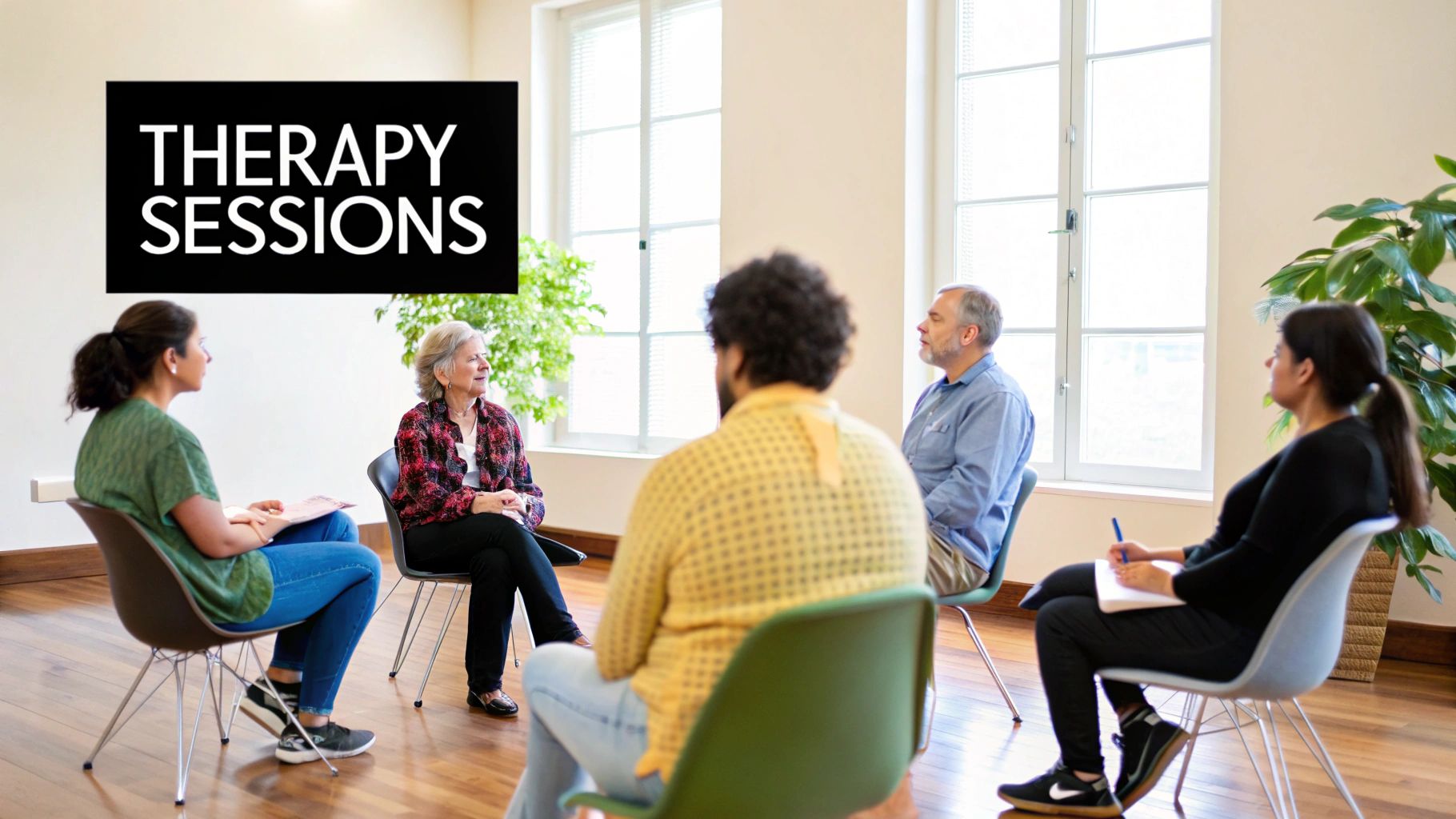
Finishing a residential treatment program is a massive accomplishment, but it’s important to see it for what it is: the end of the beginning. Think of it less like crossing a finish line and more like graduating from boot camp. You’ve been given the tools, the training, and a solid foundation, but now you have to apply it all in the real world.
This next phase is where discharge planning and aftercare become so critical. They act as a bridge, connecting the structured, safe environment of rehab to the complexities of your new life in recovery.
A good rehab center won’t just send you on your way with a handshake. The process of preparing for your return home often starts weeks before your discharge date. You’ll work closely with your primary therapist to develop a detailed aftercare plan, which is essentially your personal roadmap for navigating life post-treatment. This isn’t some generic checklist; it’s a guide built around your specific needs, strengths, and challenges.
Building Your Post-Rehab Support System
Walking away from the 24/7 support of a treatment facility can feel like stepping off a cliff. That’s precisely why a solid aftercare plan focuses so heavily on building a new support network before you leave. The goal is to have a safety net already in place from day one.
This plan is your first line of defense against relapse and your guide to continuing the personal growth you started. The core components usually include:
- Ongoing Therapy: Setting up regular appointments with a therapist who can help you continue processing challenges and celebrating wins.
- Support Group Meetings: Finding local meetings for groups like Alcoholics Anonymous (AA), Narcotics Anonymous (NA), or SMART Recovery that fit your schedule and personality.
- Medical Follow-ups: Scheduling appointments with doctors for medication management or to address any physical health issues.
This continuation of care is what helps lock in the progress you’ve worked so hard for. You can learn more about how these pieces fit together in our guide to aftercare and relapse prevention.
Practical Strategies for Everyday Life
A strong aftercare plan goes beyond just scheduling appointments. It gets into the real-world details of your daily routine. You and your therapist will dig into your personal triggers—the specific people, places, emotions, or even times of day that could put your sobriety at risk.
From there, you’ll brainstorm concrete, practical strategies for dealing with them head-on.
An aftercare plan is your personal recovery playbook. It turns the question of “What do I do if…” into a confident “I know exactly what to do when…”
For instance, if you know that a stressful workday is a major trigger, your plan might include a five-minute breathing exercise you can do at your desk or having a supportive friend on speed dial. If old friendships are a source of temptation, you’ll work on scripts for setting clear boundaries. This kind of proactive planning is a crucial part of what to expect from rehab as you get closer to leaving—it helps you shift from reacting to life to taking charge of it.
Considering Sober Living Homes
For many, going straight from the highly structured environment of rehab back home feels like too big of a leap. This is where a sober living home can be an incredibly helpful stepping stone. These are substance-free group homes that provide a structured environment as you ease back into daily life.
Sober living offers a unique mix of freedom and accountability. You can get a job or go back to school, but you do it while living with peers who are just as committed to recovery as you are. These homes have rules, like curfews and mandatory house meetings, which reinforce the healthy routines you built in treatment. It’s a powerful way to solidify your foundation before taking the full plunge into independent living.
Common Questions and Concerns About Rehab
Taking the leap into rehab is a huge decision, so it’s only natural to have a head full of questions. The unknown can feel overwhelming, but getting straight answers is the best way to quiet those fears. Let’s tackle some of the most common concerns people have, so you can walk in feeling prepared and confident, not anxious.
Our goal here is to pull back the curtain on the rehab experience. When you replace uncertainty with real information, you can stop worrying about the “what ifs” and start focusing on the healing ahead.
Can I Use My Phone or Have Visitors?
This is easily one of the first things people ask. The short answer is yes, but with some structure, especially at the beginning. Nearly every facility has rules about outside contact, and they exist for a very good reason.
You can expect an initial “blackout” period, which usually lasts from three to seven days. During this time, you probably won’t have access to your phone, the internet, or visitors. This isn’t a punishment—it’s a therapeutic tool. It gives you a chance to disconnect from the daily stressors and triggers back home and fully immerse yourself in treatment. It’s a crucial window for you to settle in and focus completely on yourself.
After that initial phase, things open up. Most centers allow scheduled phone calls and limited time for electronics. Visits from family and friends are also typically scheduled, often on weekends. Many of the best programs even incorporate these visits into family therapy sessions, turning a simple hello into a powerful part of everyone’s healing process.
Call Now – Your Journey to Recovery Begins Today!

Take the first step towards a healthier life! Call now to connect with our compassionate team and start your recovery journey today. Your path to healing awaits!
Our recovery specialists are available 24/7 to provide support, and all calls are confidential and free. Reach out anytime – we’re here to help!
How Long Does a Rehab Program Last?
There’s no magic number here, because the best program length is the one that fits your needs. That said, you’ll most commonly see options for 30, 60, or 90 days.
- 30-Day Programs: These are fantastic for getting you stabilized, through detox safely, and armed with the basic tools for recovery. Think of it as a powerful running start.
- 60- and 90-Day Programs: While a month is great, the research is pretty clear: longer stays often lead to better, more lasting results. Staying for 60 or 90 days gives you invaluable time to practice your new coping skills, dig into the deeper issues, and truly solidify healthy habits in a safe place before heading home.
Your clinical team will sit down with you and figure out the right timeline. They’ll recommend a duration that gives you the strongest possible foundation for a lifetime of recovery.
Is My Treatment Completely Confidential?
Absolutely. Your privacy isn’t just a promise; it’s protected by federal law. Reputable rehab centers operate under strict confidentiality rules, most importantly the Health Insurance Portability and Accountability Act (HIPAA).
This means every single part of your treatment is kept 100% private.
“Your presence at the facility, your personal health information, and everything you discuss in therapy sessions cannot be shared with anyone—not your family, your friends, or your boss—without your direct, written permission.”
This legal protection is the bedrock of trust between you and your care team. It creates the safe space you need to be completely honest, which is where real healing begins. You can rest assured that your story is yours to share, only if and when you decide to.
What Happens If I Relapse After I Leave?
This is a deep-seated fear for many, but it’s important to start thinking about relapse in a new way. A relapse is not a moral failure, and it doesn’t mean your recovery is a lost cause. It’s simply a sign that your aftercare plan might need a tune-up.
Recovery is a lifelong journey of growth, not a one-time event that demands perfection. If a relapse occurs, the most important thing you can do is reach out for help right away. Call your therapist, your sponsor, or someone in your support network. This is exactly what your aftercare plan is designed for.
Think of it like a warning light on your car’s dashboard. It doesn’t mean the car is totaled; it’s just alerting you that something needs attention. A relapse is an opportunity to pinpoint a new trigger, strengthen your coping skills, and get back on track—this time, with even more wisdom and experience.
Taking that first step is often the hardest part, but you don’t have to do it alone. If you or someone you care about is struggling, the team at Addiction Helpline America is available 24/7 to offer confidential support and guidance. You can find the right path to recovery by visiting their website and start your journey toward a healthier life today.
Our helpline is 100%
free & confidential
If you or someone you care about is struggling with drug or alcohol addiction, we can help you explore your recovery options. Don’t face this challenge alone—seek support from us.
Programs
Resources
Will my insurance
cover addiction
treatment?
We're ready to help
Find the best
drug or alcohol treatment
center
Are you or a loved one struggling with addiction? Call today to speak to a treatment expert.




